
The orthopteran family Rhaphidophoridae of the suborder Ensifera has a worldwide distribution. Common names for these insects include jumping wētā, cave wētā, cave crickets, camelback crickets, camel crickets, Hogan bugs, spider crickets ,land shrimp, and sand treaders. Those occurring in New Zealand and Australia are typically referred to as jumping or cave wētā. Most are found in forest environments or within caves, animal burrows, cellars, under stones, or in wood or similar environments. All species are flightless and nocturnal, usually with long antennae and legs. More than 500 species of Rhaphidophoridae are described.
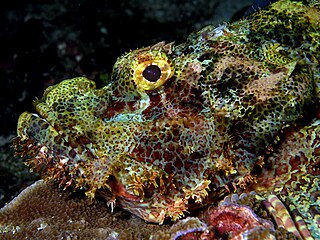
The Scorpaenidae are a family of mostly marine fish that includes many of the world's most venomous species. As their name suggests, scorpionfish have a type of "sting" in the form of sharp spines coated with venomous mucus. The family is a large one, with hundreds of members. They are widespread in tropical and temperate seas but mostly found in the Indo-Pacific. They should not be confused with the cabezones, of the genus Scorpaenichthys, which belong to a separate, though related, family, Cottidae.

The bean weevils or seed beetles are a subfamily (Bruchinae) of beetles, now placed in the family Chrysomelidae, though they have historically been treated as a separate family. They are granivores, and typically infest various kinds of seeds or beans, living most of their lives inside a single seed. The subfamily includes about 1,650 species and are found worldwide.
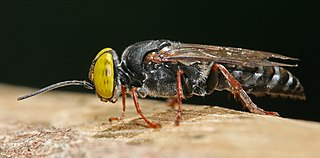
The Crabronidae are a large paraphyletic group of wasps, including nearly all of the species formerly comprising the now-defunct superfamily Sphecoidea. It collectively includes well over 200 genera, containing well over 9000 species. Crabronids were originally a part of the Sphecidae, but the latter name is now restricted to a separate family based on what was once the subfamily Sphecinae. Several of the subfamilies of the Crabronidae are often treated as families in their own right, as is true of the most recent phylogenies.

The Myrmecophilidae or ant-loving crickets are rarely encountered relatives of mole crickets. They are very small, wingless, and flattened, so resemble small cockroach nymphs. The few genera contain fewer than 100 species. Ant crickets are yellow, brown, or nearly black in color. They do not produce sound, and lack both wings and tympanal organs ("ears") on the front tibia.

Tetrigidae is an ancient family in the order Orthoptera, which also includes similar families such as crickets, grasshoppers, and their allies. Species within the Tetrigidae are variously called groundhoppers, pygmy grasshoppers, pygmy devils or "grouse locusts".

Gryllacrididae are a family of non-jumping insects in the suborder Ensifera occurring worldwide, known commonly as leaf-rolling crickets or raspy crickets. The family historically has been broadly defined to include what are presently several other families, such as Stenopelmatidae and Rhaphidophoridae, now considered separate. As presently defined, the family contains two subfamilies: Gryllacridinae and Hyperbaeninae. They are commonly wingless and nocturnal. In the daytime, most species rest in shelters made from folded leaves sewn with silk. Some species use silk to burrow in sand, earth or wood. Raspy crickets evolved the ability to produce silk independently from other insects, but their silk has many convergent features to silkworm silk, being made of long, repetitive proteins with an extended beta-sheet structure.

The Cecidomyiinae, commonly known as gall midges or gall gnats, is the largest subfamily in Cecidomyiidae with over 600 genera and more than 5000 described species. This subfamily is best known for its members that induce galls on plants, but there are also many species that are fungivores, parasitoids, or predators as maggots.

Jerusalem crickets are a group of large, flightless insects in the genera Ammopelmatus and Stenopelmatus, together comprising the tribe Stenopelmatini. The former genus is native to the western United States and parts of Mexico, while the latter genus is from Central America.
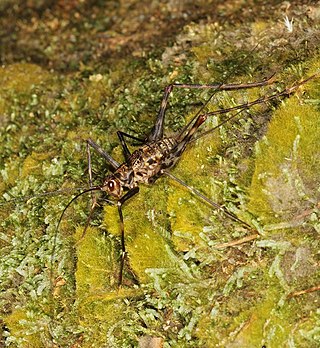
Phalangopsinae, occasionally known as spider crickets, are a subfamily of crickets in the family Phalangopsidae. Members of Phalangopsinae are found worldwide in tropical and subtropical regions. Most species in the subfamily are nocturnal and can be found in rocky areas, near fallen wood, and the understory of forests. Some species are gregarious, gathering in large numbers.
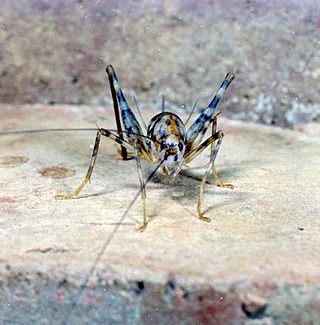
Ceuthophilus is a genus of insects in the cave cricket family Rhaphidophoridae. It contains most of the species that are known commonly as camel crickets.
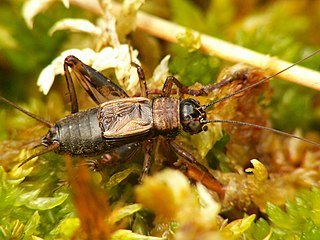
Nemobiinae is a subfamily of the newly constituted Trigonidiidae, one of the cricket families. The type genus is Nemobius, which includes the wood cricket, but members of this subfamily may also be known as ground crickets or "pygmy field crickets".
Euhadenoecus is a genus of camel crickets in the family Rhaphidophoridae. There are at least four described species in Euhadenoecus.

Pentacentrinae is a subfamily of crickets in the family Gryllidae. Sometimes known as 'Silent Litter Crickets', they occur in tropical Asia, Africa and the Americas. The tribe Lissotrachelini Hubbell, 1938 has been moved to the Nemobiinae.

Hadenoecini is a tribe of cave crickets in the family Rhaphidophoridae. There are two genera and nine described species. It is sometimes considered a synonym of the subfamily Dolichopodainae.

The Phalangopsidae are a recently reconstituted family of crickets, based on the type genus PhalangopsisServille, 1831 from South America. Priority for family-group names based on this genus dates from Blanchard's "Phalangopsites".
Lissotrachelus is an Asian genus of crickets, typical of the tribe Lissotrachelini; species records range from southern China, Indo-China to Borneo.
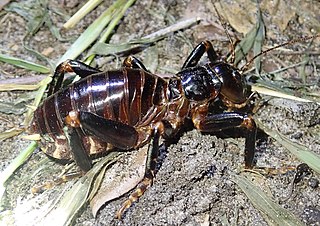
Stenopelmatinae is the sole subfamily in the family Stenopelmatidae. There are about 7 genera and more than 50 described species in Stenopelmatinae.

The Obrimini are the most species-rich tribe of the Phasmatodea family of the Heteropterygidae native to Southeast Asia.
Luzarinaeis a subfamily of crickets in the family Phalangopsidae.















